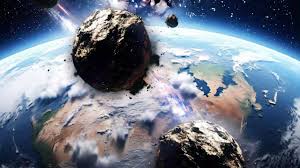Asteroid 2025 CL3 to Pass Close to Earth Today: Everything You Need to Know
By Lokmat English Desk | Updated: February 13, 2025 17:46 IST2025-02-13T17:45:35+5:302025-02-13T17:46:12+5:30
An asteroid named 2025 CL3, measuring approximately 93 feet in diameter, is set to pass close to Earth today, ...

Asteroid 2025 CL3 to Pass Close to Earth Today: Everything You Need to Know
An asteroid named 2025 CL3, measuring approximately 93 feet in diameter, is set to pass close to Earth today, February 13, 2025, at 7:06 PM IST. Traveling at a speed of 44,933 kilometers per hour, the asteroid’s proximity to our planet is what draws attention. While the speed of the asteroid is typical for celestial objects within our solar system, experts emphasize that the real focus should be on understanding the science behind the event rather than any immediate concerns about potential risks.
A Safe Distance from Earth
Asteroid 2025 CL3 will pass Earth at a distance of approximately 3.56 million kilometers, which is considered a safe margin. To put it into perspective, the average distance from Earth to the Moon is about 384,400 kilometers. While the asteroid’s close pass is notable in astronomical terms, its distance ensures there is no cause for concern.
Why There’s No Need to Worry
Despite asteroid 2025 CL3’s size and speed, it does not meet the criteria for being considered a threat. NASA defines potentially hazardous objects as those larger than 150 meters that come within 7.4 million kilometers of Earth. Since this asteroid is smaller and will remain well outside the danger zone, there is no risk of it impacting our planet.
NASA's Center for Near-Earth Object Studies (CNEOS) is responsible for tracking asteroids like 2025 CL3. Through advanced radar systems and constant monitoring, NASA keeps a watchful eye on thousands of objects approaching Earth. This vigilance is crucial in preparing for any future space-related threats. While the close pass of asteroid 2025 CL3 may grab attention, there’s no cause for concern. Thanks to NASA's continuous monitoring, we can rest easy knowing the asteroid is on a safe trajectory, underscoring the importance of space surveillance in protecting our planet from potential cosmic dangers.
Open in app